
Elephantstay is a non profit enterprise under the Prakochabaan Foundation in Ayutthaya, Thailand. The mission of the enterprise is educate people about the importance of elephants in Thai history and culture as well as caring for elephants. [1]

Elephantstay is a non profit enterprise under the Prakochabaan Foundation in Ayutthaya, Thailand. The mission of the enterprise is educate people about the importance of elephants in Thai history and culture as well as caring for elephants. [1]
Elephantstay is based at the Royal Elephant Kraal & Village, a working elephant village in Ayutthaya, 80 kilometres north of Bangkok.
The Prakochabaan Foundation and the Ayutthaya Elephant Palace and Royal Elephant Kraal Village were founded by Laithongrien Meepan in April 2005. Laithongrien Meepan (Pi Om) is a Zoologist. Founder and Director of the Prakochabaan Foundation, he is an expert on elephant breeding, training, history and culture. He received the Tan Khun Paen Din (Outstanding Social Contributors Award) in 2010.
His wife Romthongsai Meepan (Pi Lek) has committed her life to elephants and their welfare. Romthongsai managed the Ayutthaya Elephant Palace for many years, and specializes in educating Thai people about elephants. She liaisons with local government and businesses promoting elephants and the issues they face. The Prakochabaan Foundation aims to protect and conserve elephants, encourage the culture of elephants and the development of mahouts and elephants, and to raise their status to the noble position they once held in Thai society. The foundation is also a World Elephant Day associate.
The Royal Elephant Kraal & Village was established in 1996, and is home to 90 elephants (Oct 2014). Today a world heritage site, the Royal Elephant Kraal is steeped in elephant history. It dates back to the 16th century and was historically a compound where wild elephants were captured and kept.
For hundreds of years the Kings of Thailand would attend the Royal Elephant Round Up and choose the best and strongest elephants that would work and live alongside the Thai people, and be used for labor or the military. The last annual roundup from the wild was in 1906, a spectacular display and testament to the King's power and skills of the mahouts. Note: The term "kraal" means "an enclosure into which are driven wild elephants which are to be tamed and educated," according to the 1913 Websters dictionary.
Elephantstay was established by Michelle Reedy and Ewa Narkiewicz in 2006. The pair travelled Thailand and visited several elephant camps before settling at the Royal Elephant Kraal. They were impressed with the work and vision of Laithongrein Meepan and wanted to make a difference to the Thai elephants. Michelle Reedy was in management before pursuing animal studies and working as a zookeeper for 9 years. Ewa Narkiewicz was a photographic based artist, with a degree in Fine Arts. She also has a Bachelor of Arts, degree majoring in History.
Elephantstay has been established in response to the increasing aging population of working elephants. The Elephantstay project looks after old retired elephants, giving them specialized care required for older elephants. Guests from all over the world work alongside the mahouts and get involved in the care of the elephants and life at the Elephant Kraal & Village.
Each guest is allocated their own elephant and will care for the elephant during their stay doing everything from cleaning, feeding, riding and bathing their elephant. This gives people an opportunity to work with the elephants, learn about elephants and Thai Elephant culture. The Elephantstay experience will ensure both retirement and an income to support these older elephants. The elephants will continue to have interaction with humans and other elephants; but they will lead the life that is desired by an old elephant: bathing in the river, having dust baths, grazing and socialising with other elephants.
The Royal Elephant Kraal has a nursery and is committed to the conservation of the species. They run an active breeding program via natural breeding. It is the most successful in the world with 70 successful births since 2000 (until May 1, 2018).
The Royal Elephant Kraal is proud to be issued the new national Elephant Identification papers. Due to their founder, Laithongrien (Pi Om) Meepan’s vision and efforts, the government adopted his idea for a centralized system that ensures all legal elephants are issued with these comprehensive ID’s that act as a passport and will be used to monitor ownership and all travel. An important aspect of the passports will be to also register bull elephant's ivory.
In recognition of Pi Om’s invaluable knowledge and contribution to the new system, the government used the same elephant as Royal Kraal and Elephantstay logo for the cover design of the passports. The colour of the passports is pink which is the official color of the King of Thailand. This new computerized centralized system will impact the illegal trade, capture and use of wild elephants and the illegal ivory trade. New born elephants will need to be registered within 30 days of birth which will also help to protect all elephants.
The Kraal also acts as an elephant rehabilitation center for dangerous elephants. They are being trained and cared for. Ewa Narkiewicz says about Laithongrein Meepan: “Yes, he has an incredible ability to understand elephants...we’ve seen him retrain killer bulls that have been condemned to be shot by the government.” [2]
Cases

The Ayutthaya Kingdom or the Empire of Ayutthaya was a Siamese kingdom that existed in Southeast Asia from 1351 to 1767, centered around the city of Ayutthaya, in Siam, or present-day Thailand. European travellers in the early 16th century called Ayutthaya one of the three great powers of Asia. The Ayutthaya Kingdom is considered to be the precursor of modern Thailand, and its developments are an important part of the history of Thailand.

Lan Xang or Lancang was a Lao kingdom that held the area of present-day Laos from 1353 to 1707. For three and a half centuries, Lan Xang was one of the largest kingdoms in Southeast Asia. The kingdom is the basis for Laos's national historic and cultural identity.

King Narai the Great or Ramathibodi III was the 27th monarch of Ayutthaya Kingdom, the 4th and last monarch of the Prasat Thong dynasty. He was the king of Ayutthaya Kingdom from 1656 to 1688 and arguably the most famous king of the Prasat Thong dynasty.
The culture of Thailand is a unique blend of various influences that have evolved over time. Local customs, animist beliefs, Buddhist traditions, and regional ethnic and cultural practices have all played a role in shaping Thai culture. Thainess, which refers to the distinctive qualities that define the national identity of Thailand, is evident in the country's history, customs, and traditions. While Buddhism remains the dominant religion in Thailand with more than 40,000 temples, Islam, Christianity, and other faiths are also practiced.

Thai literature is the literature of the Thai people, almost exclusively written in the Thai language. Most of imaginative literary works in Thai, before the 19th century, were composed in poetry. Prose was reserved for historical records, chronicles, and legal documents. Consequently, the poetical forms in the Thai language are both numerous and highly developed. The corpus of Thailand's pre-modern poetic works is large. Thus, although many literary works were lost with the sack of Ayutthaya in 1767, Thailand still possesses a large number of epic poems or long poetic tales —some with original stories and some with stories drawn from foreign sources. There is thus a sharp contrast between the Thai literary tradition and that of other East Asian literary traditions, such as Chinese and Japanese, where long poetic tales are rare and epic poems are almost non-existent. The Thai classical literature exerted a considerable influence on the literature of neighboring countries in mainland Southeast Asia, especially Cambodia and Burma.

The Surin Elephant Round-up is a cultural festival held every year in Surin Province, Isan, Thailand. Usually the event is organized during the third week of November on the weekend. The festival has its origins in the royal hunts which were conducted in Surin Province during medieval times. The indigenous residents of Surin, the Kuy, have been traditional practitioners of corralling elephants and training them as working animals. When the Ayutthaya Kingdom came into power these hunts were converted into a public extravaganza and wild elephants were replaced with tame ones. The festival, in its contemporary form, was first organized in the 1960s when civil war in Cambodia and the steady decline in economic value of elephants forced the elephant handlers (mahouts) to seek occupations in the entertainment and tourism industry.

Phetracha was a king of the Ayutthaya Kingdom, usurping the throne from his predecessor King Narai and originally settled in Phluluang Village. His dynasty, the Ban Phlu Luang dynasty, was the last ruling house of the Ayutthaya Kingdom.
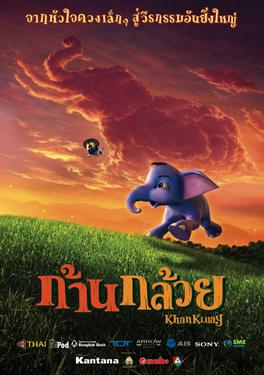
Khan Kluay is a 2006 Thai computer-animated adventure film set in Ayutthaya-era Siam about a Thai elephant who wanders away from his mother and becomes the war elephant for King Naresuan. It is based on the story Chao Phraya Prap Hongsawadee by Ariya Jintapanichkarn. The film took three years to make, and was released on May 18, 2006, in Thailand. In 2007, the film was released as The Blue Elephant in the United States on September 2, and as Jumbo in India in December 25.

Pinnawala Elephant Orphanage, is a captive breeding and conservation institute for wild Asian elephants located at Pinnawala village, 13 km (8.1 mi) northeast of Kegalle town in Sabaragamuwa Province of Sri Lanka. Pinnawala has the largest herd of captive elephants in the world. In 2023, there were 71 elephants, including 30 males and 41 females from 3 generations, living in Pinnawala.

Maha Thammaracha, Maha Thammarachathirat, or Sanphet I, formerly known as Khun Phirenthorathep, was a king of Ayutthaya Kingdom from the Sukhothai dynasty, ruling from 1569 to 1590. As a powerful Sukhothai noble, Phirenthorathep gradually rose to power. After playing many political turns, he was eventually crowned as the King of Siam.
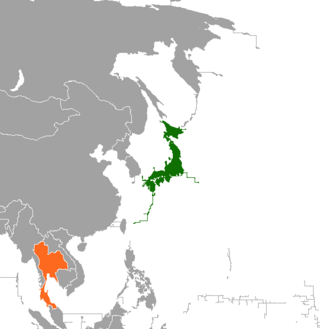
Japan–Thailand relations refer to bilateral relations between Japan and Thailand. Contacts had an early start with Japanese trade on Red seal ships and the installation of Japanese communities on Siamese soil, only to be broken off with Japan's period of seclusion. Contacts resumed in the 19th century and developed to the point where Japan is today one of Thailand's foremost economic partners. Thailand and Japan share the distinction of never having lost sovereignty to the European powers during the colonial period, and both countries were Axis partners during the later part of World War II.

Maha Chakkraphat was king of the Ayutthaya kingdom from 1548 to 1564 and 1568 to 1569. Originally called Prince Thianracha, or Prince Tien, he was put on the throne by Khun Phiren Thorathep and his supporters of the Sukhothai clan, who had staged a coup by killing the usurper King Worawongsathirat and Si Sudachan.
Worawongsathirat was a usurper in the Ayutthaya Kingdom, ruling for only 42 days in 1548 before being assassinated. Siamese chronicles relate that Worawongsathirat attainted the crown — his kingship is not accepted by most traditional historians.

The Burmese–Siamese War (1547–1549), also known as the Shwehti war was the first war fought between the Toungoo dynasty of Burma and the Ayutthaya Kingdom of Siam, and the first of the Burmese–Siamese wars that would continue until the middle of the 19th century. The war is notable for the introduction of early modern warfare to the region. It is also notable in Thai history for the death in battle of Siamese Queen Suriyothai on her war elephant; the conflict is often referred to in Thailand as the War that Led to the Loss of Queen Suriyothai (สงครามคราวเสียสมเด็จพระสุริโยไท).
Mingyi Swa was heir apparent of Burma from 1581 to 1593. The eldest son of King Nanda of the Toungoo Dynasty led three out of the five Burmese invasions of Siam between 1584 and 1593, all of which ended in complete failure. He died in action during the fifth invasion in 1593. In prevailing Thai history, he was killed in single combat by King Naresuan. However no other accounts, including the earliest Siamese records and European accounts, mention a formal elephant duel between the two. The Burmese chronicles say Swa was felled by a Siamese mortar round.
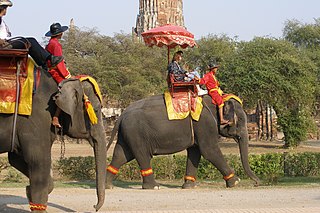
The elephant has been a contributor to Thai society and its icon for many centuries. The elephant has had a considerable impact on Thai culture. The Thai elephant is the official national animal of Thailand. The elephant found in Thailand is the Indian elephant, a subspecies of the Asian elephant. In the early-1900s there were an estimated 100,000 captive elephants in Thailand. In mid-2007 there were an estimated 3,456 captive elephants left in Thailand and roughly a thousand wild elephants. By 2017 the number of captive elephants had risen to an estimated 3,783. The elephant became an endangered species in Thailand in 1986.

When Elephants Were Young is a 2015 Canadian documentary film directed by World Elephant Day Co-Founder Patricia Sims and narrated by William Shatner. It follows the story of Wok and his young elephant Nong Mai, as they street beg in Bangkok until the opportunity comes to release the elephant to the wild. The film premiered at the Whistler Film Festival on December 5, 2015.
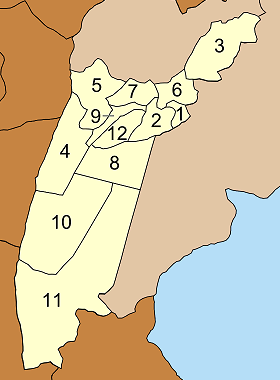
Bang Chang is a tambon (sub-district) of Amphawa District, Samut Songkhram Province, central Thailand.

Following the Sack of Ayutthaya and the collapse of the Ayutthaya Kingdom (1351–1767) during the Burmese–Siamese War (1765–1767), a power vacuum left Siam divided into 5 separate states—Phimai, Phitsanulok, Sawangburi, Nakhon Si Thammarat, and Thonburi. The Burmese invasion force, having returned to Burma off their successful sack of Ayutthaya and to defend its homeland against an imposing Chinese invasion of Ava, were too preoccupied to take advantage of the power vacuum in Siam.
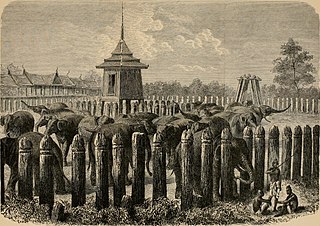
Elephant Kraal of Ayutthaya, or Elephant Corral of Ayutthaya is a historic place in Ayutthaya Province, Thailand. It is considered part of the Ayutthaya Historical Park.